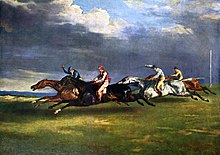Flying gallop
The flying gallop is the representation in the painting of galloping horses, but also other animals, in which both the front and rear legs are stretched out and do not touch the ground. This type of stance does not occur naturally in horses. Exceptions are situations when they jump over something.
The motif was common in Sassanid art . The hunting scene of King Chosrau II on a rock relief in Taq-e-Bostan in Iran from the 4th century is well known. The flying gallop and other secular scenes of Sassanid art also found their way into early Christian Armenian sacred architecture, for example as a relief of the hunting prince Manuel Amatuni on the church of Ptghni from the 6th / 7th centuries. Century.

